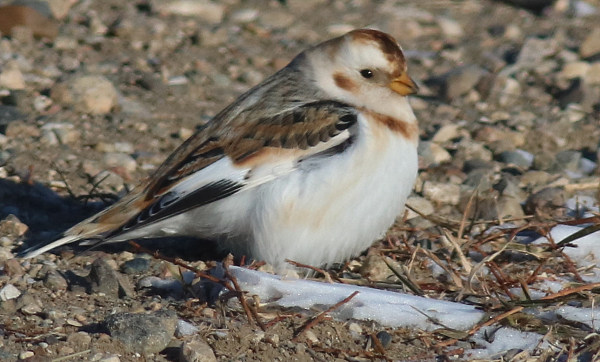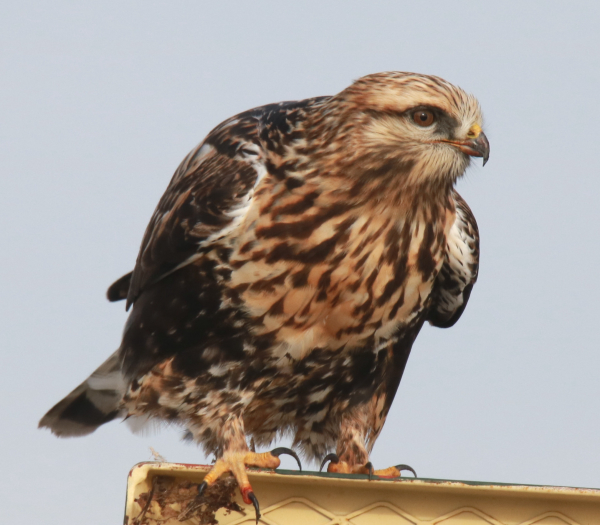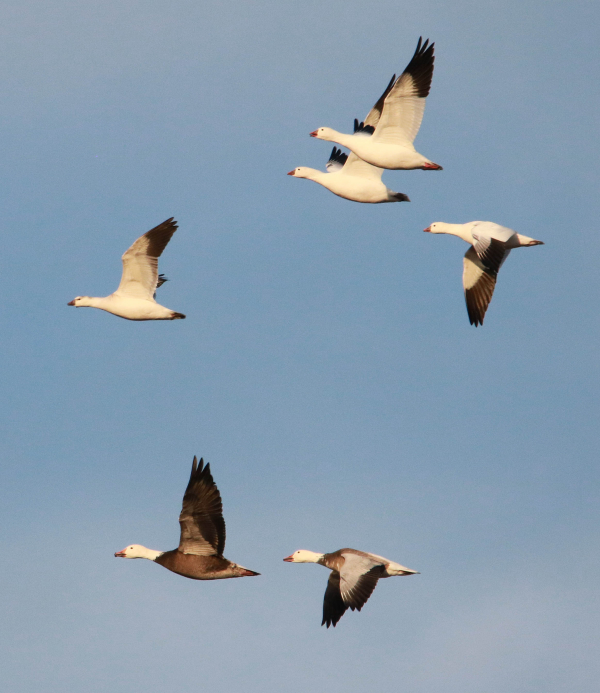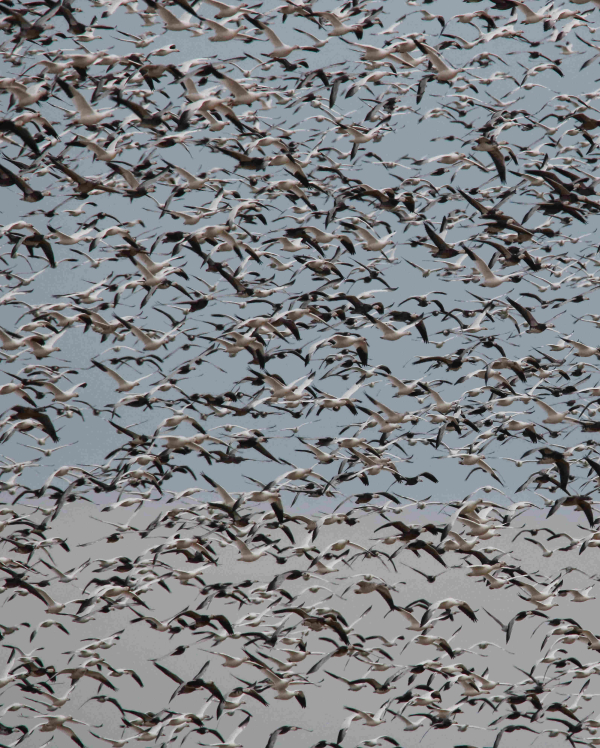
The first 4 Snow Buntings of the year quickly increased to a flock of about 40.

A close portrait of a hunting Rough-legged Hawk was part of a series of photos taken Sunday and highlighted in the Bird Photography feature in this issue.

A foursome of Ross’s Geese, including a first-year Ross’s, pictured with a pair of blue morph Snow Geese.

A very small portion of one of the ‘clouds of geese’ that is stagging close to our editor’s North Dakota office.
|
As blizzard winds blew the first snow of the season across the northern prairie last Thursday, it was fitting to see the first 4 Snow Buntings of the year fly up, showing their telltale winter plumage only to land just 3 feet away. Across the lake I could see about 2,000 Snow Geese feeding on the edge of the wind-blown water, 1 of at least 4 expansive flocks of geese made up of 5 species within 4 miles of my office. That’s when another transfer from the Arctic appeared, a Rough-legged Hawk that was facing west but sailing south, propelled by the intense north wind.
A big flock of cold weather ducks braved the waves in the lake, about 120 Lesser Scaup and maybe 20 Redheads. The geese and Snow Buntings persisted through the weekend, with the buntings increasing by 10 times on that little hill by Friday. There were also 25 Buffleheads on a lake 2 miles south of there, and many Mallards feeding on the edges of the goose flocks.
Before the storms, Wednesday I ventured to Bismarck, after checking out about 100 White-fronted Geese with a few Cackling Geese mixed among them feeding and loafing just 300 yards south of home. Only a Rough-legged Hawk was evident for the next 40 miles until I sighted a flock of about 20 Sandhill Cranes migrating by circling high then gliding southbound. I pulled off the side of the road and turned off my vehicle so I could listen to the cranes, which for me make one of the iconic sounds in nature. Thereafter I found large flocks of geese dominated by Snow Geese 15 miles north, 25 miles farther north, 15 miles west, and 15 miles farther west – along with a small feeding flock of Sandhill Cranes adjacent to the second concentration of geese. Hence, there were periodic big goose concentrations across the Missouri Coteau – but none to rival the 4 big flocks surrounding my house.
After the Storms
By Sunday afternoon, the weather was warming and the wind was light, drawing me outdoors when the sun appeared to be breaking through the veil of light clouds. Less than a mile south I appreciated the chance to photograph a Rough-legged Hawk that turned out to be a “species ambassador,” allowing me to spend an hour observing and photographing it in close proximity – an enjoyable birding experience that I describe in this issue’s Bird Photography feature.
As usual, clouds of geese dominated the avifauna with a cloud of geese to the south, and a huge cloud to the north, with a big flock in between. An adult Bald Eagle was perched a quarter mile east of the huge cloud up north, and the other obvious addition after the storms were a few flocks 40 or more Lapland Longspurs, including a few scattered Snow Buntings among the longspurs.
By Monday, the deep lakes were ice-free again, and even Melody’s Marsh had broad openings in the thinning layer of ice with some Cackling, White-fronted, and Canada Geese loafing on the shore and a lone pair of Lesser Scaup swimming next to the ice. The south cloud of geese was much larger, 2 or 3 times largerl plus there were 2 clouds of geese to the north, which suggested the birds from the day before had split up. But there was also a new super-cloud of geese about 10 miles northeast, just behind my friend Bruce’s farmstead. Every day there are more geese, which is remarkable, but not unexpected.
There was also a surprise late Red-tailed Hawk, an adult Bald Eagle, and for the first time in a long time, there were pheasants along the roadways – 5 hens and a young male, 3 cocks, 5 hens, and a lone male – along with 2 flocks of Lapland Longspurs, 1 with a couple Snow Buntings mixed in. During the past couple weeks I’ve seen a scattering of solo Great Horned Owls, the most recent was perched just 1½ miles south of my office – will the first Snowy Owl appear pronto? Sunday and Monday I sure felt like I should be finding a Snowy perched on an tall open perch or standing on a local hilltop.
After the touch of winter Thursday-Friday-Saturday, Monday’s 50 degrees felt pretty fine and helped to fuel a productive birding drive. There was a flock of 5 American Coots that took me by surprise, but later I saw about 8 times that number, plus a big flock of about a hundred Mallards on the edge of the ice in a mostly hidden marsh. Species diversity among ducks has dwindled, but I’m expecting to see some of the cold-water ducks arrive next week – namely Common Goldeneyes and Common Mergansers, along with more Buffleheads and Hooded Mergansers.
Even Closer to Home
My feeders have been very predictable the past couple weeks, but an occasional visit by an American Goldfinch on Sunday brought new hope of more “different” birds, and Monday I was very surprised by a bathing Common Redpoll, the first of the season. I’ve also heard an occasional Blue Jay call, but no takers at my feeder in spite of having plenty of peanuts on the menu. I also see an occasional lone Dark-eyed Junco, but the usual birds are holding down the fort, including Hairy Woodpeckers, Downy Woodpeckers, White-breasted Nuthatches, and House Finches, some males still with rich red colors.
We should enjoy another week of goose music in my neighborhood, but next week Monday the weatherman predicts a high of 20 degrees and a low of 10 – yikes! That will freeze things up pretty tight, except maybe the deepest lake as long as the wind blows. Soon my attention will turn south toward my SoDak raptor hotspot to observe and photograph wintering eagles, falcons, hawks, and other birds. The change of seasons will close one door, but open another – with Thanksgiving on the horizon. Enjoy the week ahead, and seek out some avian excitement of your own, near or far.
Article and photos by Paul Konrad
Share your bird sightings and photographs at editorstbw2@gmail.com